|
Home
|
|
PALAMPUR
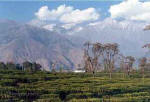 The Kangra valley of which Palampur (1249 m) is a major station, was the
`Trigarta' of old. It was one of the leading hill states and was once a
part of the kingdom of Jalandhara. In local
parlance, the world for `lots of water' is `pulum'. This is what has given
Palampur its name and it is water that has given the valley so much of its
character. Countless streams and brooks criss - cross the landscape and in
their intricate mesh, hold tea gardens and rice paddies. The town of
Palampur came into being when Dr. Jameson, Superintendent Botanical
Gardens, North-West Frontier Province. introduced the tea bush from Almora
in 1849. The bush thrived and so did the town which became a focus of the
European tea estate owners. Kangra tea, with its centre at Palampur,
has been internationally acclaimed since then. To further bless the
area with remarkable natural beauty, the Dhauladhar ranges rise
dramatically from the earth, just beyond Palampur. The town itself has
some interesting colonical architecture and the area around is richly
garnished with historical temples and forts - and scores of picturesque
tam lets. The Kangra valley of which Palampur (1249 m) is a major station, was the
`Trigarta' of old. It was one of the leading hill states and was once a
part of the kingdom of Jalandhara. In local
parlance, the world for `lots of water' is `pulum'. This is what has given
Palampur its name and it is water that has given the valley so much of its
character. Countless streams and brooks criss - cross the landscape and in
their intricate mesh, hold tea gardens and rice paddies. The town of
Palampur came into being when Dr. Jameson, Superintendent Botanical
Gardens, North-West Frontier Province. introduced the tea bush from Almora
in 1849. The bush thrived and so did the town which became a focus of the
European tea estate owners. Kangra tea, with its centre at Palampur,
has been internationally acclaimed since then. To further bless the
area with remarkable natural beauty, the Dhauladhar ranges rise
dramatically from the earth, just beyond Palampur. The town itself has
some interesting colonical architecture and the area around is richly
garnished with historical temples and forts - and scores of picturesque
tam lets.
How to get There
The airport at
Gaggal (Kangra) is 37 km from Palampur. The road gauge railway reaches
Pathankot which is 115 km from Palampur - and the narrow gauge railway
comes right upto Maranda, 4 km from the town. Taxies and buses are
available at both places. By road, Palampur is 545 km from Delhi.
Climate
In winter, the temperature
can get quite low when heavy woollens are required,. It is warm in summer
and cottons are recommended.
|
The Nagri
Resort |
|
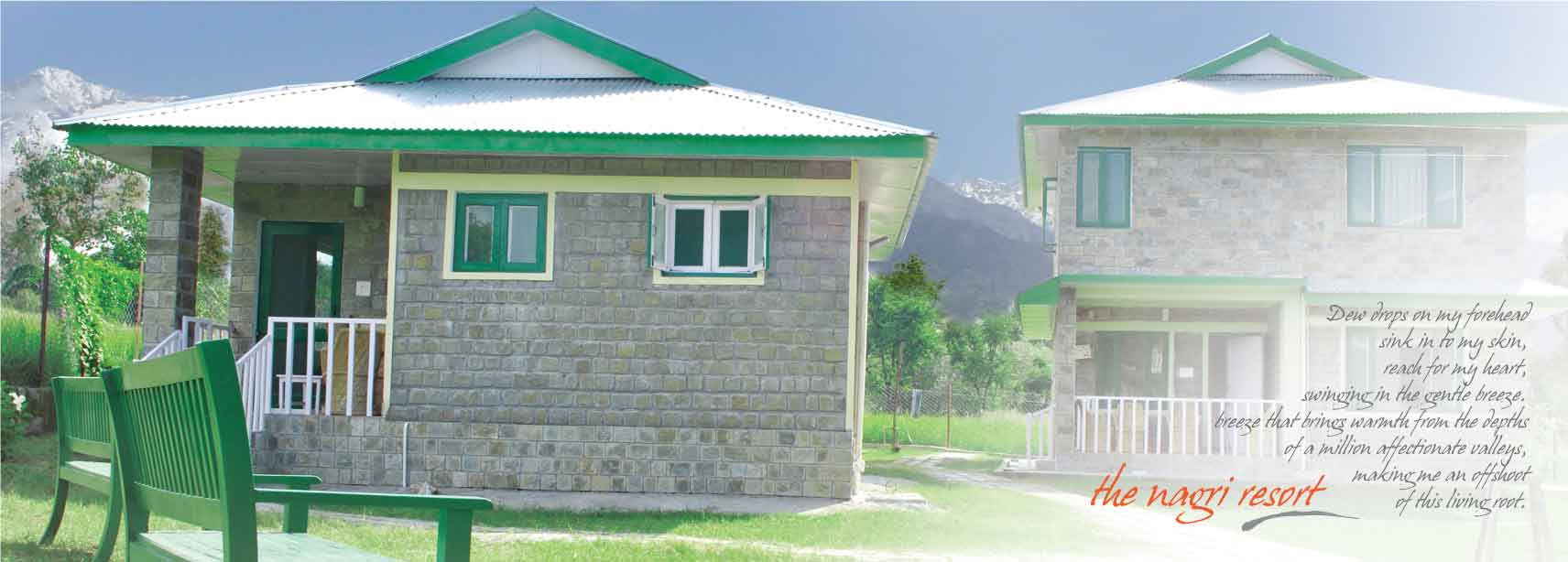 |
|
The Nagri Resort - the
back alley to paradise. A blissful cluster of cottages amongst natural
and man-made luxuries. Just 10 kilometers from Palampur, the Nagri
Resorts is perched among paddy fields, a stream called Khadd and
picture perfect views of the snow capped Dhauladhar.
Read more |
|
|
Search for Hotels in Palampur
Places of Interest in and around
Palampur
Tea Factory (1.5 km) : At the very start
of town, the tea factory of the co-operative society, offers an insight to
the processing of Kangra tea.
Church of St. John in the Wilderness (200 m)
: This attractive church ,
very close to the hotel and surrounded by poinsettias, is built on a low
rise. This was reconstructed in 1929 and has several memorial
tables.
Tample of Bunslamata (2 km) : One
can walk through tea gardens and open fields or drive to reach this
historical temple which was originally built about five centuries
ago.
Neugal Khad
: Close to the temple of Bundlamata,
is this 300m wide chasm, through which the Bundla stream flows.
Immediately ahead are the Dhauladhar mountain.
 Gopalpur
(1200mt.) 10 km from Palampur is Gopalpur where the Forest Department has set
up a zoo called Dhauldhar Nature Park Gopalpur
(1200mt.) 10 km from Palampur is Gopalpur where the Forest Department has set
up a zoo called Dhauldhar Nature Park
Chamunda
devi (18 km) :
Legend has it that two demons. Chand and
Mund tried to harass the goddess Ambika. Enraged, Ambika knitted her brows
and from their folds emerged a terrifying from of Kali, who slew the
demons. Pleased, Ambika declared that Kali would now be worshipped here as
`Chamunda'. Himachal Tourism also runs a `Yatri Niwas' at this sacred place.
Andretta (13 km)
: The Artist's Village
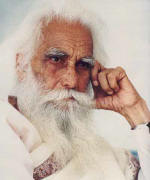 Some places in the world are made for inspiration.
Kangra Valley, with its spectacular backdrop of the mighty Dhauladhar, the
Milky Mountains, has forever been known to attract artists, the Kangra
school of miniature painting being just one notable example. What Kangra
was to art some 200 years ago. Andretta, a tiny village 14 km south of
Palampur, is to artist in the present century. Nestling amongst
the Some places in the world are made for inspiration.
Kangra Valley, with its spectacular backdrop of the mighty Dhauladhar, the
Milky Mountains, has forever been known to attract artists, the Kangra
school of miniature painting being just one notable example. What Kangra
was to art some 200 years ago. Andretta, a tiny village 14 km south of
Palampur, is to artist in the present century. Nestling amongst
the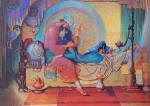 rolling plains of Kangra Valley, with a wide panorama
of snowy mountams its constant backdrop, Andretta has attracted artists of
many hues. The village was brought to prominence by Ms. Norah Richards,
the famous writer and dramatist. Known popularly as the `Nani of Punjabi
Drama', Ms. Richards' writings exhibited her deep sensibility to life and
people around her. Equally well known, and as sensitively marked, was her
contemporary Sir Sobha Singh. Honored with the title of Padma Shri, Sobha
Singh's paintings perhaps show the influence of the Kangra school,
especially in the use of colours and their shades.
S. Sobha Singh
Painting Gallery rolling plains of Kangra Valley, with a wide panorama
of snowy mountams its constant backdrop, Andretta has attracted artists of
many hues. The village was brought to prominence by Ms. Norah Richards,
the famous writer and dramatist. Known popularly as the `Nani of Punjabi
Drama', Ms. Richards' writings exhibited her deep sensibility to life and
people around her. Equally well known, and as sensitively marked, was her
contemporary Sir Sobha Singh. Honored with the title of Padma Shri, Sobha
Singh's paintings perhaps show the influence of the Kangra school,
especially in the use of colours and their shades.
S. Sobha Singh
Painting Gallery
Sujanpur
Tira (700mt)
 42 km from Palampur situated on the
banks of foaming Beas, the historical town Sujanpur Tira (Tira mean
palace) was built by Raja Sandra Chand, who had ascended to the
throne when only ten years of age. The Tira Palace was the
winter residence of Sansar Chand and the Alampur palace on the other side
of the Beas was his summer resort. 42 km from Palampur situated on the
banks of foaming Beas, the historical town Sujanpur Tira (Tira mean
palace) was built by Raja Sandra Chand, who had ascended to the
throne when only ten years of age. The Tira Palace was the
winter residence of Sansar Chand and the Alampur palace on the other side
of the Beas was his summer resort.
The township is
picturesque having a vast natural ‘chaugan’ (flat ground)and grassy plain
surrounded by the trees where traditional annual fair of holi is
held for four days. A sainik school is located here. The temple of
Gauri Shankar has life size statues of Lord Shiva and his consort
Parvati in Ashatadhathu. A real wealth of paintings lies in the
Narbadeshwar temple in the town.Hardly any inch of the space has been left
anadorned. The town has also the temple of Lord Ganesha and Laxmi Narayan.
Appropriately, the town was once a major trade center and known for the
craftmanship of the jwellers
More Information
on Sujanpur Tira
Baijnath Temple
 One of the most remarkable monuments of the Kangra
valley is the temple of Baijnath. Baijnath is situated East of Dharamsala
on the main road that leads from the Dharmsala to Mandi. Baijnath is
in reality the appellation of the chief temple dedicated to Siva
Vaidyanatha (“Lord of Physicians”) by which the town itself has become
known. The original name of the town was Kiragrama. This we learn from the
two extensive Sarada inscriptions incised on stone slabs, which in elegant
and florid Sanskrit verse give the history of the foundation of a temple,
by two local merchants. "There is in Trigarata," we read in the
inscription, "the pleasant village of Kiragrama, the home of numerous
virtues where the river called Binduka, leaping from the lap of the
mountain, with glittering wide-waves resembling playing-balls, merrily
plays, like a bright maiden in the first bloom of youth. That village is
protected by the strong-armed Rajanaka Lakshmana." The river Binduka, so
well described by the poet, is the modern Binwa, a tributary of the
Beas. The date of the inscription is expressed both in the Saptarshi
and in the Saka eras. Cunningham first read the Saka date as 726,
corresponding with A.D. 804. The true date, however, must be the Saka year
1126 corresponding with A.D .1204. One of the most remarkable monuments of the Kangra
valley is the temple of Baijnath. Baijnath is situated East of Dharamsala
on the main road that leads from the Dharmsala to Mandi. Baijnath is
in reality the appellation of the chief temple dedicated to Siva
Vaidyanatha (“Lord of Physicians”) by which the town itself has become
known. The original name of the town was Kiragrama. This we learn from the
two extensive Sarada inscriptions incised on stone slabs, which in elegant
and florid Sanskrit verse give the history of the foundation of a temple,
by two local merchants. "There is in Trigarata," we read in the
inscription, "the pleasant village of Kiragrama, the home of numerous
virtues where the river called Binduka, leaping from the lap of the
mountain, with glittering wide-waves resembling playing-balls, merrily
plays, like a bright maiden in the first bloom of youth. That village is
protected by the strong-armed Rajanaka Lakshmana." The river Binduka, so
well described by the poet, is the modern Binwa, a tributary of the
Beas. The date of the inscription is expressed both in the Saptarshi
and in the Saka eras. Cunningham first read the Saka date as 726,
corresponding with A.D. 804. The true date, however, must be the Saka year
1126 corresponding with A.D .1204.
The Baijnath temple is
oriented due west. It consists of a puri or adytum. 8 feet squre inside
and 18 feet outside, surmounted by a spire of the usual conical shape, and
of a mandapa or front hall, 20 feet square inside, covered with a low
pyramid shaped roof. The adytum, which contains the linga known as Vaidaya
natha, is entered through a small anteroom with two pillars in antis. The
roof of the mandapa is supported by four massive pillars connected by
raised benches which form, as it were, a passage leading to the entrance
of the sanctum. The architraves resting on these pillars divide the space
of the ceiling into nine compartments, each of which is closed by means of
corbelling slabs.
In front of the mandapa rises a stately porch
resting on four columns. "The shafts of these pillars," Fergusson remarks
"are plain cylinders, of very classical proportions, and the bases also
show that they are only slightly removed from classical design. The square
plinth, the two toruses, the cavetto or hollow molding between are all
classical, but partially hidden by Hindu ornamentation, of great elegance
but unlike anything found afterwards."
Set amidst a backdrop of
Snow-clad Mountains and lush green Valleys the temple is visible from a
far distance. Close flows the Binwa Khund (stream). Considered sacred by
local people. The temple surrounding area has been developed into a
beautiful lawn and flowerbeds so that the devotees are able to rest a
while amidst congenial surrounding.
Taragarh Palace(1200mt)
|
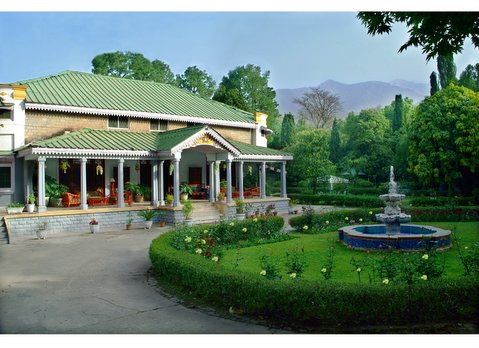 |
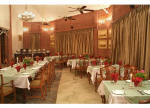 |
 |
 |
|
Imperial Dining Hall |
Shivalik Suite |
Polo ponies in the Arena Polo
ground |
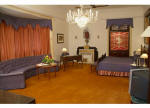 |
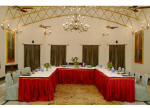 |
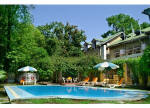 |
|
Maharani Suite |
Rajgarh Darbar Hall |
Swimming
Pool |
12 km from Palampur is Alhilal (land of crescent moon) a heritage
property now converted into superb guest establishment on a 15 acre forest
estate. Taragarh combines all the charm and beauty of a remote and
peaceful mountain resorts with the splendor and elegance of
princely preserve.
|
NORAH
RICHARDS AND HER RETREAT AT
ANDRETTA
Mrs. Richards had many admirers both in India and abroad. In
Punjab the people had acclaimed her as the great grandmother of
Punjabi theatre or "the main spirit behind
the drama movement in the province". Prithvi Raj Kapoor, late Prof.
G. D. Sondhi, Prof. B. C. Sanyal and Mrs. Freda Bedj and host of
other celebrities had always held her in high esteem.
Read
more....
|
|
|
|
Andretta Pottery |
|
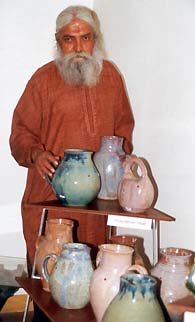
Mansimran Singh or Minni, as he is
affectionately called, is an artist - potter of significant merit.
His English wife, Mary, is also a professional potter.
Mansimran Singh learnt pottery from his father, late Sardar
Gurcharan Singh at Delhi Blue Art Pottery, 1956-59. He then went to
England to train under Bernard Leach and Geoffrey Whiting. In 1960,
he was invited to the Berlin Arts Festival and the 500th anniversary
of the Dresden Art Gallery. He visited the Meissen’s porcelain
factory and also went to Vellauries, France, where Picasso made his
distinctive ceramics. His first solo show was held in Jaipur in
1961, followed by exhibitions in Mumbai, Kolkata, Delhi and Chennai.
In 1966 he showed at the Commonwealth Institute, London. In 1976, he
helped set up the pottery studio at Garhi. In late 1985 he moved to
Andretta in Himachal Pradesh where he set up a pottery and crafts
society and marketing center with support from the Handicrafts
Board. Earlier in 1985, he went with his wife, potter Mary Singh to
the UK on a British Council grant, visiting British potters working
in glazed earthenware. This led to the shift from high-fired
stoneware pottery to low-fired earthenware or red clay work at
Andretta, a thriving pottery centre. A managing trustee of Delhi
Blue Pottery Trust, Mansimran Singh continues to be active in the
teaching and promotion of pottery. Mansimran Singh lives and works
in Andretta, Himachal Pradesh
|
|
http://123himachal.com/
| |
|
|
















